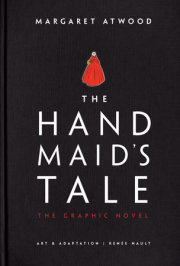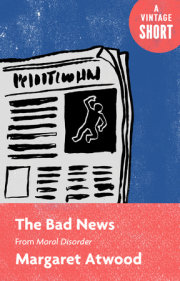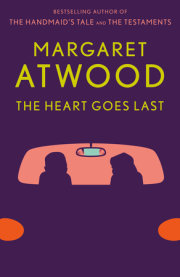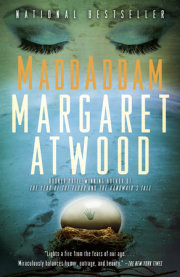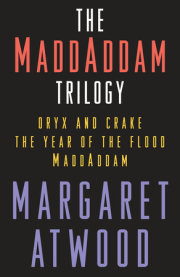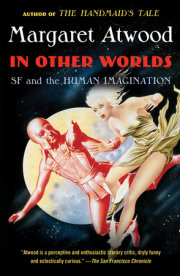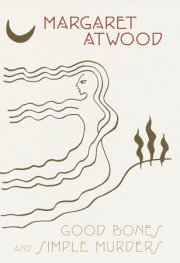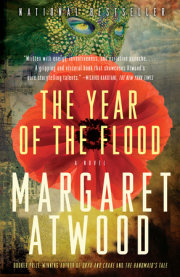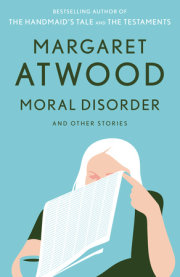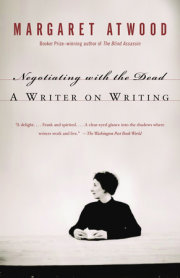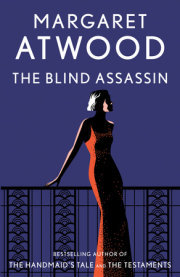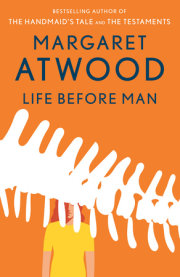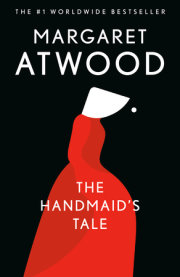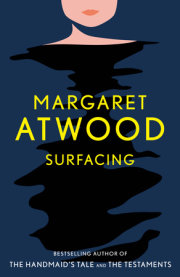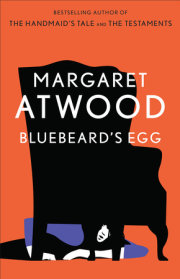Chapter 1
i
TIG & NELL
first aid
Nell came home one day just before dinnertime and found the front door open. The car was gone. There was a trail of blood splotches on the steps, and once she was inside the house, she followed it along the hall carpet and into the kitchen. There was a knife on the cutting board, one of Tig’s favourites, Japanese steel, very sharp—and beside it, a bloodstained carrot, one end severed. Their daughter, nine at the time, was nowhere to be found.
What were the possible scenarios? Desperadoes had broken in. Tig had tried to defend himself against them, using the knife (though how to explain the carrot?), and had been wounded. The desperadoes had made off with him, their daughter, and their car. Nell should call the police.
Or else Tig had been cooking, had sliced himself with the knife, had judged that he needed stitches, and had driven himself to the hospital, taking their daughter with him to avoid leaving her by herself. This was more likely. He must have been in too much of a hurry to leave a note.
Nell got out the bottle of carpet cleaner and sprayed the blood spots: they would be much harder to get out once they’d dried. Then she wiped the blood off the kitchen floor and, after a pause, off the carrot. It was a perfectly good carrot; no need for it to go to waste.
Time passed. Suspense built. She was at the point of phoning all the hospitals in the vicinity to see if Tig was there when he came back, hand bandaged. He was in a jovial mood, as was their daughter. What an adventure they’d had! The blood was just pouring out, they reported. The tea towel Tig had used for wrapping the cut had been soaked! Yes, driving had been a challenge, said Tig—he didn’t say dangerous—but who could wait for a taxi, and he’d managed all right with basically just one hand since he’d needed to keep the other one raised, and the blood was trickling off his elbow, and they’d sewn him up quickly at the hospital because he was dripping all over everything, and anyway, here they were! Luckily not an artery, or it would be a different story. (It was indeed a different story when Tig told it a little later, to Nell: his bravado had been an act—he hadn’t wanted to frighten their daughter—and he’d been worried that he would pass out if the blood loss got out of control, and then what?)
“I need a drink,” said Tig.
“So do I,” said Nell. “We can have scrambled eggs.” Whatever Tig had been planning to do with the carrot was no longer on the agenda.
The tea towel had been brought back in a plastic bag. It was bright red but beginning to brown at the edges. Nell put it to soak in cold water, which was the best way to deal with bloodstained fabrics.
But what would I have done if I’d been here? she wondered. Not a Band-Aid: insufficient. A tourniquet? She’d had perfunctory instruction in those at Girl Guides. They’d done wrist sprains too. Minor emergencies were her domain, but not major ones. Major ones were Tig’s.
That was some time ago. Early autumn, as she recalls, a year in the later 1980s. There were personal computers then, of a lumbering kind. And printers: the paper for them came with the pages joined together at top and bottom, and had holes along the sides, in perforated strips that you had to tear off. No cellphones though, which was why Nell hadn’t been able to text or call Tig and ask him where he was, and also what had caused the blood?
How much waiting we used to do, she thinks. Waiting without knowing. So many blanks we couldn’t fill in, so many mysteries. So little information. Now it’s the first decade of the twenty-first century, space-time is denser, it’s crowded, you can barely move because the air is so packed with this and that. You can’t get away from people: they’re in touch, they’re touching, they’re only a touch away. Is that better, or worse?
She switches her attention to the room the two of them are in right at this moment. It’s in a nondescript high-rise on Bloor Street, near the viaduct. She and Tig are sitting in chairs that are something like schoolroom chairs—there is in fact a whiteboard at the front—and a man called Mr. Foote is talking. The people in the other chairs, who are also listening to Mr. Foote, are at least thirty years younger than Tig and Nell; some of them perhaps forty years younger. Just kids.
“If it’s a motorcycle crash,” says Mr. Foote, “you don’t want to take off the helmet, do ya. Because you don’t know what’s gonna be in there, eh?” He moves his hand in front of him, circularly, as if cleaning a window.
Good point, thinks Nell. She imagines the glass of a helmet, smeared. Inside, a face that is no longer a face. A face of mush.
Mr. Foote has a talent for conjuring up such images. He has a graphic way of speaking, being from Newfoundland. He doesn’t tiptoe around. He’s built on a square plan: wide torso, thick legs, a short distance between ear and shoulder. It’s a balanced shape, with a low centre of gravity. Mr. Foote would not be easy to upend. Nell expects that’s been tried, in bars—he looks as if he’d know his way around a bar fight, but also as if he wouldn’t get into any of those he couldn’t win. If pushed too hard he’d throw the challenger through a window, calmly—“You needs to keep calm,” he has already said twice—then check to make sure there were no bones broken. If there were, he’d splint them, and treat the victim for cuts and abrasions. Mr. Foote is an all-in-one package. In fact, he’s a paramedic, but that does not come out until later in the day.
He’s carrying a black leather binder and wearing a long-sleeved zip-fronted sweatshirt with the St. John Ambulance logo on it, as if he’s a team coach, which in a way he is: he’s teaching them first aid. At the end of the day there will be a test and they will each get a certificate. All of them are in this room because they need this certificate: their companies have sent them. Nell and Tig are the same. Thanks to a family connection of Tig’s, they’re giving talks on a nature-tour cruise ship, birds for him, butterflies for her: their hobbies. So they are technically staff, and all staff on this ship have to get the certificate. It’s mandatory, their ship contact has told them.
What hasn’t been said is that the majority of the passengers—the guests—the clientele—will not be young, to put it mildly. Some of them will be older than Nell and Tig. Truly ancient. Such people can be expected to topple over at any minute, and then it will be certificates to the rescue.
Nell and Tig are unlikely to be doing any actual rescuing: younger people will leap in, Nell’s counting on that. In a pinch, Nell will dither and claim she’s forgotten what to do, which will be true. What will Tig do? He will say, Stand back, give them room. Something like that.
It’s known—it’s been rumoured—that these ships have extra freezers on them, just in case. Nell pictures the distress of a server who opens the wrong freezer by mistake, to be confronted by the appalled, congealed stare of some unlucky passenger for whom the certificate has not proved sufficient.
Mr. Foote stands at the front of the room, running his gaze over today’s crop of students. His expression is possibly neutral, or faintly amused. Bunch of know-nothing softies, he’s most likely thinking. City people. “There’s what to do, and there’s what not to do,” he says. “I’ll be telling you both. First, ya don’t go screaming around like a headless chicken. Even if buddy’s minus his own head.”
But headless chickens can’t scream, Nell thinks. Or she assumes they can’t. But she takes the meaning. Keep your head in an emergency, they say. Mr. Foote would add, “If ya can.” He would definitely want them to keep their heads.
“You can fix a lot of things,” Mr. Foote is saying. “But not if there’s no head. That’s one thing I can’t teach ya.” It’s a joke, Nell guesses, but Mr. Foote does not signal jokes. He’s deadpan.
“Say you’re in a restaurant.” Mr. Foote, having dealt with motorcycle crashes, has moved on to asphyxiation. “And buddy starts choking. The question you needs to ask is: Can they talk? Ask them if you can hit them on the back. If they say yes in words, it’s not too bad because they can still breathe, eh? But what’s likely—a lot of people are embarrassed, they stand up, and what do they do? They go to the washroom, because they don’t want to be making a fuss. Calling attention. But you got to go in there with them, you got to follow them, because they can die. Right on the floor, before you even notice they’re gone.” He gives a meaningful nod. He has known instances, the nod says. He’s been there. He’s seen it happen. But he got there too late.
Mr. Foote knows his stuff, Nell thinks. The exact same thing has almost happened to her. The choking, the going to the washroom, the not wanting to make a fuss. Embarrassment can be lethal, she sees now. Mr. Foote has nailed it.
“Then you got to bend them forward,” Mr. Foote continues. “Five whacks on the back—the glob of meat or the dumpling or the fish bone or whatever can shoot out of them right then and there. But if not, you got to do the Heimlich manoeuvre. Thing is, if they can’t talk, they can’t exactly give you permission, plus they might be turning blue and passing out. You just got to do it. Maybe you’ll break a rib, but at least they’ll be alive, eh?” He grins a little, or Nell assumes it’s a grin. A sort of mouth twitch. “That’s the endgame, eh? Alive!”
They run through the Heimlich manoeuvre and the right way of hitting someone on the back. According to Mr. Foote, the combination of these two things would almost always work, but you had to get in there soon enough: in first aid, timing is everything. “That’s why it’s called first, eh? It’s not the effing tax department, excuse my French, they can take all day, but you got maybe four minutes.”
Now, he says, they will have a coffee break, and after that, they will do drowning and mouth-to-mouth, followed by hypothermia; and, after lunch, heart attacks and defibrillators. It’s a lot for one day.
Drowning is fairly simple. “First, you need to get the water out. It’ll pour out if you let gravity be your friend, eh? Turn ’em on the side, empty ’em out, but fast.” Mr. Foote has dealt with numerous drownings: he’s lived near water all his life. “Turn ’em on their back to clear the airways, check for breathing, check for pulse, make sure someone calls 911. If there’s no breathing, you needs to do the mouth-to-mouth. Now this gadget I’m showing you, it’s a CPR barrier guard, it’s for the mouth-to-mouth, ’cause sometimes they’ll throw up, like, and you don’t need to have that in your own mouth. Anyways, there’s the germs, eh? You should carry one a these on you at all times.” Mr. Foote has a supply of them. They can be purchased at the end of the day.
Nell makes a mental note to get one. How has she managed to live without a mouth barrier guard until now? How feckless.
In order to practise the mouth-to-mouth, the room is divided into pairs. Each pair is given a red plastic torso with a bald white tip-back head and a yoga mat for kneeling on while they bring their shared torso back to life. Pinch the nose shut, cover the mouth with yours, give five rescue breaths, letting the chest rise each time, then perform five chest compressions. Repeat. Meanwhile, the other person calls 911, after which they take over with the chest compressions. These can get tiring, it’s hard on the wrists. Mr. Foote stalks the room, checking everyone’s technique. “You’re gettin’ there,” he says.
Tig says now that he’s down on the mat, Nell will have to call 911 to get someone to lift him back up again, considering the state of his knees. Nell giggles into the plastic mouth, sabotaging her rescue breath. “I just hope nobody drowns on our watch,” she says. “Because they’ll probably stay drowned.” Tig says he understands it’s a relatively painless way to go. You are said to hear bells.
When they’ve all brought their plastic torsos back to life, they move on to hypothermia and shock. Both involve blankets. Mr. Foote tells an amazing story about a man on a ski trip who went out the door of a cabin to take a leak, without a flashlight, through deep snow, and fell into a melt well around the base of a tree, and couldn’t get out, and wasn’t found until morning. He was stiff as a board and cold as a mackerel, said Mr. Foote, not a breath in him, and as for his heart, it was silent as the tomb. But someone else in that cabin had taken the CPR course, and they worked on the possibly dead person for six hours—six hours!—and brought him back.
“You keep going. You don’t give up,” says Mr. Foote. “Because you never know.”
They break for lunch. Nell and Tig find a little Italian restaurant tucked into one of the soulless high-rise buildings, and order a glass of red wine each, and eat quite good pizza. Nell says she’s going to have a wallet card made that says “In Case of Accident Call Mr. Foote,” and Tig says they should run Mr. Foote for prime minister, he could give the whole country mouth-to-mouth. He thinks Mr. Foote has been in the navy. Nell says no, he’s a spy. Tig says maybe he’s been a pirate, and Nell says no, he’s definitely an alien from outer space, and being a first-aid instructor called Mr. Foote is a perfect front.
They’re both feeling silly, and also incompetent. Nell is sure that if confronted with any of these emergencies—the drowning person, the one in shock, the frozen one—she will panic, and everything Mr. Foote has taught them will go right out of her head.
Copyright © 2023 by Margaret Atwood. All rights reserved. No part of this excerpt may be reproduced or reprinted without permission in writing from the publisher.











